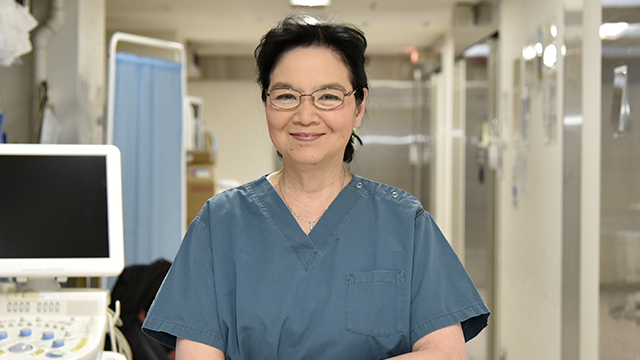ASOURCE®TIMES

藤田医科大学ばんたね病院
脳神経外科教授、院長補佐
加藤 庸子
1978年愛知医科大学医学部卒業。
1980年名古屋保健衛生大学(現:藤田医科大学)脳神経外科研修医。
1981年中華人民共和国蘇州医学院付属第一病院脳神経外科留学。
1986年オーストリア・グラーツ大学留学。
2006年に現職となり、2010年に藤田保健衛生大学病院(現:藤田医科大学病院)総合救命救急センター・センター長。2014年から藤田保健衛生大学坂文種報德會病院(現:藤田医科大学ばんたね病院)脳血管ストロークセンター・センター長も兼任。
2006年に日本初の女性脳外科教授となった加藤庸子氏。患者さんに寄り添う外科医であり、国内外の女性医師をサポートする教育者でもある。この姿勢を貫く加藤氏の原動力について伺った。
脳外科医の道を歩み始めて40年が経ちました。この間に脳外科を取り巻く環境は様々に変遷してきましたが、病に悩み苦しむ患者さんを救うために、常に技術を磨き、患者さんに寄り添う脳外科医としての私の生き方は変わっていません。
1978年に大学を卒業し、80年に名古屋保健衛生大学(現・藤田医科大学)の脳神経外科の研修医になりました。脳外科を選んだのは、外科医だった父の影響もありますが、他の外科と違い、医師一人でこじんまりと手術ができるところに惹かれたからです。入局した女性は私一人で、物珍しさもあってか、先輩や上司に可愛がってもらい、伸び伸びと診療や研究に取り組むことができました。当時、脳外科医局には“神の手”と言われた佐野公俊先生がおられ、佐野先生や多くの先輩の指導を受けながら、積極的に技術を習得しました。
脳外科の手術は患者さんの命に関わるため、大きなプレッシャーがかかりますが、目の前のことに集中し、絶対に諦めないのが私の信条です。患者さんを治すことが医師の使命だからです。
手術の腕を上げるのはもちろんですが、患者さんの笑顔を見るために、医師として何ができるのかも常に考えてきました。病に倒れた患者さんは、心も体もどん底の状態です。一緒に病院の庭を散歩したり体操をして、心を癒やすことも続けてきました。
1990年に「日本脳神経外科女医会」を設立し、初代会長となりました。当時、女性の脳外科医は全国で30人足らずでした。医局が女性を採用しない、入局しても手術件数が少ないなどの問題があり、まず男女の差の解消を課題としました。
「男女で仕事の内容に差があるのはおかしい」と感じるようになったのは、1981年に中国の蘇州に留学したことがきっかけでした。人民服を着た多くの市民が自転車で移動する時代です。男女の別なくみんな働き、食事は外食、男性が育児をするのも当たり前でした。そうしなければ、家計が苦しいという事情が背景にあったのですが、社会生活を送る上では男も女もない、という現実を目の当たりにしました。
現在、国内に約1万人いる脳神経外科医のうち、女性は6%を占め、20~30歳代に限れば15%もいます。女性医師の存在感は大きくなっています。
2008年には「藤田保健衛生大学女子医学生・女医の会」の発起人にもなりました。当時、女性医師が大学病院の研修医の半数を占めていました。しかし現実には女性医師が出産・育児をしながら勤務できる環境が整っておらず、休職後の職場復帰が難しいケースもありました。そこで、診療科の枠を超えて女性医師が交流し、モチベーションを高めていく場として、女性医師専用の仮眠室や、女性だけでくつろげる畳の部屋を設置しました。
海外にも目を向け、1996年のアジア脳神経外科女医会の創立にも関わりました。参加国の様々な学会で講演したり、現場で彼女らの悩みを聞いて、アドバイスをしてきました。教育支援先は広がり、25年間で訪れた国は40カ国以上に上ります。2019年にはインド、インドネシア、ベトナム、ウズベキスタンなどアジアを中心に13カ国を24回訪問しました。新型コロナウイルスの感染拡大の影響により、今はインターネットでのコミュニケーションとなっていますが、脳外科教育のあり方や、医療資源の有効活用などについて話し合っています。
脳外科を取り巻く環境変化の一つが、医療機器の進歩です。例えば、未破裂動脈瘤のクリッピング手術は、かつては6時間を超えることもまれではありませんでしたが、今ではそんなに時間がかかると「何が起きたんだ」と問題になります。器具のスリム化、暗くて狭くて遠い場所にある瘤までのナビゲーションなどにより、血管などの障壁を避けながら、なるべく短いルートで瘤に到達できるようになりました。その結果、低侵襲、短時間で手術が行えるようになり、治療成績は大きく向上しました。
特に神経内視鏡による脳腫瘍の手術では、翌日には患者さんが体を動かせるほど、侵襲度合いが低くなりました。光源が明るいため、瘤まで安全に近付くことができ、さらに瘤のぎりぎり手前で、内視鏡の解像度を上げて接写できるため、安全で的確な手術ができるようになりました。
こうした脳外科領域の医療機器の進歩は、一方で、機器・材料の価格の上昇を伴います。手術計画をしっかりと立てることで、経費を最小限に抑えつつ、患者さんにとって最大の効果があるように、常に留意しています。
医療者は、誰もが常に激務だと思います。これは医師だけでなく、看護師、コメディカルなど医療の道を歩むことを選んだ人間の宿命でしょう。ただ、それによって疲弊してしまっては元も子もありません。病気のことで思い悩む患者さんに寄り添い、元気を分けるのが医療者です。自身がいつでも元気でいることが大切だと思います。
そのためには、十分な休息が必要です。休息の取り方、その間に何をするか、考えるかは人それぞれ違うと思いますが、例えば私はどんなに忙しいときでも、体も心も疲れたなと感じたら10~15分の休憩を取るようにしています。身体的な疲れを癒やすだけでなく、自分の気持ちを立て直すために、自分は何のために医師になったのか、患者さんの命を救い、笑顔を見たいからだ、医療者である自分の心の糧は何か、という原点に立ち返るようにしています。こうした休息を取ることによって、気持ちに張りが戻ってくるのではないでしょうか。
ただでさえ忙しい医療者は、新型コロナウイルスの影響によってさらに忙しくなっています。「休む間もない」状況だからこそ、意識的にオンオフを切り替えることが重要だと考えています。
新型コロナウイルスの影響で、外来の患者数は減っています。経過観察や術後のフォローなどでは、残念ながら直接会えない患者さんもいらっしゃるので、電話による診療などでカバーし、QOLの低下等がないことを確認しています。ある患者さんから送られてきた手紙に「病院にいる人は、みんなコロナウイルスに感染しているのでは」と書いてありました。そういう誤解を解き、過度な恐れを緩和するために、電話などによるコミュニケーションが大切です。かつて患者さんと病院の庭を散歩した時のように、心の癒やしを感じられるようなメッセージを伝えることも心がけています。